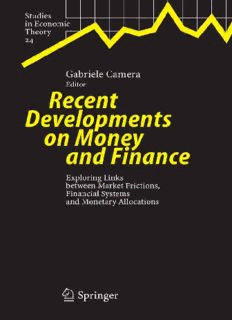
Recent Developments on Money and Finance: Exploring Links between Market Frictions, Financial Systems and Monetary Allocations (Studies in Economic Theory) PDF
Preview Recent Developments on Money and Finance: Exploring Links between Market Frictions, Financial Systems and Monetary Allocations (Studies in Economic Theory)
Studies in Economic Theory Editors Charalambos D.Aliprantis Purdue University Department ofEconomics West Lafayette,in47907-2076 USA Nicholas C.Yannelis University ofIllinois Department ofEconomics Champaign,il61820 USA Titles in the Series M.A.Khanand N.C.Yannelis(Eds.) N.Schofield Equilibrium Theory Mathematical Methods in Economics in Infinite Dimensional Spaces and Social Choice C.D.Aliprantis,K.C.Border C.D.Aliprantis,K.J.Arrow,P.Hammond, and W.A.J.Luxemburg(Eds.) F.Kubler,H.-M.Wuand N.C.Yannelis(Eds.) Positive Operators,Riesz Spaces, Assets,Beliefs,and Equilibria and Economics in Economic Dynamics D.G.Saari D.Glycopantis andN.C.Yannelis(Eds.) Geometry ofVoting Differential Information Economies C.D.Aliprantisand K.C.Border A.Citanna,J.Donaldson,H.M.Polemarchakis, Infinite Dimensional Analysis P.Siconolfiand S.E.Spear(Eds.) Essays in Dynamic J.-P.Aubin General Equilibrium Theory Dynamic Economic Theory M.Kaneko M.Kurz(Ed.) Game Theory and Mutual Misunderstanding Endogenous Economic Fluctuations S.Basov J.-F.Laslier Multidimensional Screening Tournament Solutions and Majority Voting V.Pasetta A.Alkan,C.D.Aliprantisand N.C.Yannelis Modeling Foundations ofEconomic Property (Eds.) Rights Theory Theory and Applications J.C.Moore Mathematical Methods for Economic Theory 1 J.C.Moore Mathematical Methods for Economic Theory 2 M.Majumdar,T.Mitraand K.Nishimura Optimization and Chaos K.K.Sieberg Criminal Dilemmas M.Florenzanoand C.Le Van Finite Dimensional Convexity and Optimization K.Vind Independence,Additivity,Uncertainty T.Casonand C.Noussair(Eds.) Advances in Experimental Markets F.Aleskerovand B.Monjardet Utility Maximization.Choice and Preference Gabriele Camera Editor Recent Developments on Money and Finance Exploring Links between Market Frictions, Financial Systems and Monetary Allocations With 28 Figures and 5 Tables 123 Professor Gabriele Camera Department ofEconomics Krannert School ofManagement Purdue University 47907-2056 West Lafayette,IN USA E-mail:[email protected] Cataloging-in-Publication Data Library ofCongress Control Number:2005931709 ISBN-10 3-540-27803-6 Springer Berlin Heidelberg New York ISBN-13 978-3-540-27803-0 Springer Berlin Heidelberg New York This work is subject to copyright.All rights are reserved,whether the whole or part ofthe material is con- cerned,specifically the rights oftranslation,reprinting,reuse ofillustrations,recitation,broadcasting,repro- duction on microfilm or in any other way,and storage in data banks.Duplication ofthis publication or parts thereofis permitted only under the provisions ofthe German Copyright Law ofSeptember 9,1965,in its current version,and permission for use must always be obtained from Springer-Verlag.Violations are liable for prosecution under the German Copyright Law. Springer is a part ofSpringer Science+Business Media springeronline.com © Springer-Verlag Berlin Heidelberg 2006 Printed in Germany The use ofgeneral descriptive names,registered names,trademarks,etc.in this publication does not imply, even in the absence ofa specific statement,that such names are exempt from the relevant protective laws and regulations and therefore free for general use. Cover design:Erich Kirchner Production:Helmut Petri Printing:Strauss Offsetdruck SPIN 11410249 Printed on acid-free paper – 42/3153 – 5 4 3 2 1 0 Table of Contents Recentdevelopmentsonmoneyandfinance:anintroduction GabrieleCamera ............................................ 1 PartI:Finance Chapter 1.Optimalfinancialregulation Depositinsuranceandbankregulationinamonetaryeconomy:ageneral equilibriumexposition JohnH.Boyd,ChunChang,andBruceD.Smith.................... 11 Amonetarymechanismforsharingcapital:DiamondandDybvigmeet KiyotakiandWright RicardodeO.Cavalcanti ...................................... 39 Chapter 2.Financialfragilityinsmallopeneconomies Domesticfinancialmarketfrictions,unrestrictedinternationalcapital flows,andcrisesinsmallopeneconomies GaetanoAntinolfiandElisabethHuybens ......................... 61 Inflation,growthandexchangerateregimesinsmallopeneconomies PaulaL.Hernandez-Verme..................................... 93 Chapter 3.Financialarrangementsanddynamicinefficiencies Aggregate risk sharing and equivalentfinancial mechanismsin an endowmenteconomyofincompleteparticipation PamelaLabadie ............................................. 127 Asset pricingimplicationsof efficientrisk sharingin an endowment economy PamelaLabadie ............................................. 149 PartII:Money Chapter 4.Thedistributionof moneyanditswelfareimplications Distributionalaspectsofthedivisibilityofmoney.Anexample GabrieleCamera ............................................ 163 VI TableofContents Thedistributionofmoneyandpricesinanequilibriumwithlotteries AleksanderBerentsen,GabrieleCamera,andChristopherWaller ...... 173 Chapter 5.Pricedispersion,inflationandthevalueofmoney Money,pricedispersionandwelfare BrianPetersonandShouyongShi................................ 197 Asimplesearchmodelofmoneywithheterogeneousagentsandpartial acceptability AndreiShevchenkoandRandallWright........................... 223 Chapter 6.Optimaltradingarrangementswith moneyandcredit Decentralizedcreditandmonetaryexchangewithoutpublicrecordkeeping DeanCorbaeandJosephRitter ................................. 235 Limitedparticipation,privatemoney,andcreditinaspatialmodelofmoney StephenD.Williamson ........................................ 255 Recent developments on money and finance: (cid:1) an introduction GabrieleCamera DepartmentofEconomics,KrannertSchoolofManagement,PurdueUniversity, WestLafayette,IN47907-2056,USA [email protected] This book assembles some currenttheoreticalwork on monetary theory, banking, andfinance.Thepaperspublishedinthiscollectionspanawidevarietyofthemes, frommonetarypolicytotheoptimaldesignoffinancialsystems,fromthestudyofthe causesoffinancialcrisestopaymentssystemdesign.Iamconvincedtheywillserve as a usefulreferenceto all researchersinterested in the study of financialsystems andmonetaryeconomies. Thepapersarenaturallydividedintotwoparts,oneofwhichfocusesonfinance, andtheotheronmoney.Precisely,thefirstpartisorganizedintothreechaptersdealing withoptimalfinancialregulation,financialfragilityandcrises,andoptimalfinancial arrangements.Thesecondpartiscomposedofthreemorechaptersdealingwiththe welfare implicationsof unequaldistributionsof moneyholdings,price dispersion, the value of money in heterogeneous-agentseconomies, and optimal trading and paymentarrangementsinmonetaryeconomies. TothefirstpartbelongthecontributionsofAntinolfiandHuybens,Boyd,Chang andSmith,Cavalcanti,Hernandez-Verme,andLabadie.Perhapsthecentralelement ofcommonalityofthesecontributionsistheemphasisonhowinformationalfrictions impingeontheoperationoffinancialsystems,andtradingarrangements.Suchfric- tionsareintroducedintheenvironmentbyexploiting—inseveraldifferentways—the notionofspatial/informationalseparationintroducedbyTownsend(1980).Mostpa- persinthisgroupembedthesenotionsofseparationintheoverlappinggenerations frameworkof Samuelson(1958),one of the workhorsesof monetarytheory.Cav- alcantiis the onlypaperin thisgroupthat departsfromthis modelingchoice,and insteadintroducesfrictionsusingarandom-matchingframeworkinthetraditionof KiyotakiandWright(1989). Thefirstchapterincorporatesworksthatdealwithtopicsrelatedtotheoptimality offinancialmechanisms,andbankingregulationinparticular.Theopeningpiece,by (cid:1)IwanttothankBarbaraFess,ofSpringer-Verlag,forexcellenteditorialhelp.Allthearticles, excepttwo,werepublishedinthespecialissueofEconomicTheory24(4),2004,727-732, whichcollectedpaperspresentedattheconference“RecentDevelopmentsinMoneyand Finance”heldatPurdueUniversityinMay2003.Theconferencewasorganizedjointlyby GabrieleCameraandthelateBruceD.Smith,anditwassponsoredbyPurdueUniversity’s DepartmentofEconomics,andtheCentralBankInstituteoftheFederalReserveBankof Cleveland. 2 G.Camera Boyd,ChangandSmith,fillsagapintheliteratureontheoptimaldesignofdeposit insuranceandbankregulation,inageneralequilibriumcontext.Theauthorspresent an environmentwhere banks arise endogenously due to a problem of costly state verification. There is also a moral hazard problem between banks and borrowers, andsincethereisscopeforgovernment-supplieddepositinsurance,thisgivesriseto amoralhazardproblembetweenbanksandthegovernment.Tocreateanexplicitrole forbothmoney,andbankregulationinthemodel,areserverequirementisimposedon banks.Theauthorsconsiderseveraldifferentmethodstofinancedepositinsurance: insurancepremiumcollections,taxes,andseignorage.Theanalysisshowsthatthese methodsinteractincomplexwaysandthat,ingeneral,tooheavyarelianceononetool maycauseanadverseeconomicimpact.Aninterestingnormativeimplicationofthe analysis,inparticular,isthatmonetizationofbanksbailouts’costsisnotnecessarily inefficient. Regarding the positive dimension of the analysis, the paper highlights thesignificanceofconductinganalysesofdepositinsuranceinageneralequilibrium framework.Thestudyshowshow,ingeneralequilibrium,therelationshipbetween deposit insurance financing and economic activity is complex, and often general equilibriumeffectsleadtocounter-intuitiveimplications. The contribution of Cavalcanti also focuses on optimal bank regulation. His studyexplainswhybank’sprovisionofinsidemoneyshouldbecoordinatedwiththe intermediationofcapital,aresultthatcallsintoquestionFriedman’s(1959)recom- mendationthatmoneyandcreditbeseparated.Thisintuitionisdevelopedinamodel characterizedbythesharingofstorablegoods,asinDiamondandDybvig(1983), and the creation of inside money,as in recentextensionsof the random-matching model of Kiyotaki and Wright (1989). In the model, financial intermediaries, or banks,are agentswhose informationalhistoryis commonknowledge;society can keep—andcostlesslyaccess—apublicrecordoftheiractions.Theremainingagents, called‘non-banks,’areanonymousandsometimeshaveidlecapital.Banks’infor- mationaladvantagesallowthemtobetterallocatecapitalthancannonbankers,for threemainreasons.Theseinformationaladvantagesgivebanksanincentivetomake transferstononbankers,toavoiddefection-inducedpunishments,andallowbanksto produceforotherbankerswithouthavingtousemoney(sotheircapitaluseismore efficient).Banksissue (butdo notoverissue) money,whichincreasesthe turnover ofcapital.Hence,bankscanbebothconservativeissuersofinsidemoney,butalso trustworthyreceiversofidlecapital. Thesecondchaptercomprisestwopapers,byAntinolfiandHuybens,andHer- nandez,whicharealsoconcernedwithfinancialregulation.Unlikethepriorchapter, however,themainfocushereisfinancialfragilityinsmallopeneconomies.These areeconomiesthatareopentoworldtradeandcapitalflows,butaresmallenough to be price takers on world markets. In particular, this means that their economic policiesandbehaviordonotaffectworldprices,interestrates,andincomes. AntinolfiandHuybenssetupamodelthathelpsusbetterunderstandthepossi- ble causesofinternationalfinancialcrises. Theyadoptan overlappinggenerations framework to model a small open economy and present an example in which an increaseintheworldinterestratecanbeassociatedwithaprecipitousdeclineineco- Recentdevelopmentsonmoneyandfinance:anintroduction 3 nomicactivity.Thepaperhighlightshowtheinteractionofdomesticinformational frictions,perfectcapitalmobility,andforeigninterestratescancombinetoprovoke a sudden depreciation of the exchange rate and a prolonged decline in output. In particular,theauthorsdescribeconditionsunderwhichtwodifferentequilibriaexist. Onehasahighlevelofoutputandaminorcostly-state-verificationproblem,andthe otherequilibriumhasahigherlevelofoutputandaseverecostly-state-verification problem.Inaddition,theauthorsshowhowtheirmodelcansuccessfullysimulatea crisispaththatisqualitativelyconsistentwithoccurrencessuchastheMexicanfinan- cialcrisisin1994.Animportantlessonemergingfromthisworkisthatevenasmall changeinexternalfactorscangeneratea“crisis”path,whenthisinitialshockhitsa smallopenmonetaryeconomy,iftheeconomyfeaturesacombinationofdomestic informationalfrictionswithinternationalcapitalflows. Thenextpaper,byHernandez-Verme,also focuseson thestudyofsmallopen economieswithinthecontextofanoverlappinggenerationsmodel.UnlikeAntinolfi andHuybens,however,hermainconcernistherelativemeritsofdifferentmethods forachievingpricestability.Todososhemergestheoverlappinggenerationsmodel withaspatialmodelofTownsendtocomparethemeritsofalternativeexchangerate regimes—namely,fixed and flexible. This analysis is carried out within a context wherefinancialintermediariesperformarealallocativefunction,therearemultiple reserverequirements,andtheeconomyissubjecttocreditmarketfrictions.Shefinds thereisscopeforendogenousvolatility,independentoftheexchangerateregimein place.Anotherkeyfindingisthatunderfloatingexchangerates,apositivetrade-off between domestic inflation and outputcan be exploitedunder credit rationingbut only if inflation is small. In fact, there exists an inflation threshold beyond which domesticoutputsuffers. Thethirdchapter,whichconcludesthefirstpartofthebook,presentstwocon- tributions of Labadie, both of which focus on dynamic inefficiencies and optimal financialarrangements.Precisely,thefirstpiececontributestotheliteratureonsto- chastic life-cycle models. The central theme is the study of the dynamic ineffi- cienciesthatariseinastochasticpureexchangemonetaryoverlappinggenerations economy,whererisksharingopportunitiesarelimited.Inparticular,shestudiesthe meritofdifferentfinancialmechanismsthatcanprovideintergenerationalinsurance. In additionto fiat money,these mechanismsincludeequivalentgovernment-based approaches such as risk-free bonds, state-contingent taxes, social security, or in- come insurance. Labadie considers two categories of Pareto optimal allocations, ‘conditional’ and ‘equal-treatment.’She finds that governmentinvolvementis not necessarytoachieveconditionallyParetooptimalallocations,i.e.allocationswhere agentshavestate-dependentmarginalratesofsubstitution.Aself-financingtransfer system is sufficient. However, state-contingentgovernmenttaxation is required to achieveequal-treatmentParetooptimality,i.e.allocationswhereagentshavestate- independentmarginalratesofsubstitution. Thesecondpieceisanaturalextensionofthefirst,andconsidersimplicationsfor assetpricesinanoverlappinggenerationseconomy.Here,theauthorexamineshow afinancialinstitution,whichcanbeinterpretedasaclearinghouse,caneliminatethe
Description: